-
Car Reviews
- Car News
-
Car Comparisons
Latest comparisons
- Chasing Deals
For those chasing the stylish Mazda MX-30 look but without the full electric powertrain and price premium, the M Hybrid version is the cheaper and more conventional – but less planet-saving – option.
Mazda Experiment. Shortened to MX, these are the two letters Mazda reserves for something a bit special. MX has adorned Mazda’s race and concept cars, while the evergreen MX-5 convertible has made them famous.
The moniker’s now seen on the MX-30 Electric SUV as Mazda experiments – at long last – with its first production electric vehicle. We expected the pure electric version to be kicking off this new MX dawn, but first to market instead is this MX-30 M Hybrid. Same eye-catching body as its EV stablemate, but with a far less experimental mild hybrid powerplant.
Under its unquestionably stylish skin is Mazda’s tried and tested 2.0-litre four-cylinder Skyactiv-G petrol engine, offering 114kW and 200Nm through the front wheels. It’s the same powerplant found in the similarly-sized and platform-sharing CX-30 small SUV, but with a very mild 24-volt hybrid electric system attached.
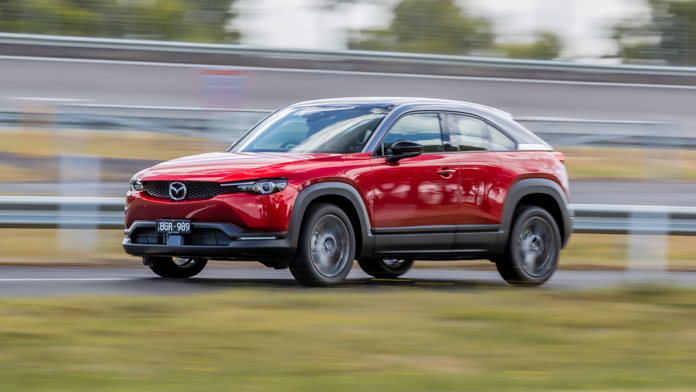
Mazda preaches this system makes idling stops smoother with less noise and vibration, allied to a more refined driving feel. Let’s hope so, because the economy gains are scant. There’s a mere 0.1L/100km (combined) improvement over the same-sized CX-30 SUV using the same engine sans mild hybrid tech.
If we gloss over that, the MX-30 M Hybrid’s a mighty characterful thing with marked and stylish points of difference versus the CX-30 – and most other small SUVs out there. Unashamedly targeting young urbanites, its dramatic coupe-style roof has been made possible by fitting Mazda RX-8-esque ‘freestyle’ doors: the rear-hinged types, or suicide doors as you may know them.
Rich with sustainable cabin bits, decent specification, strong safety and bold design elements throughout, it’s sure to appeal to those favouring the quirky and stylish over outright practicality.
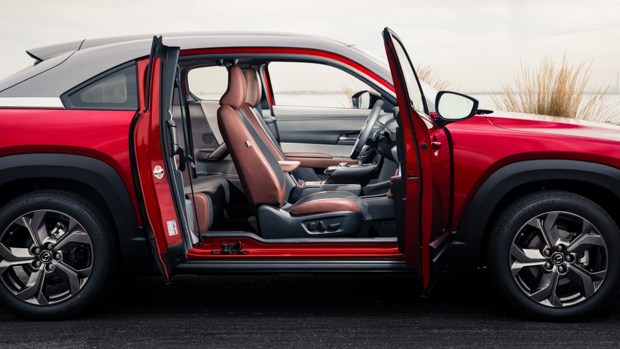
In that regard, the MX-30 M Hybrid does enough to distance itself from its CX-30 cousin to justify its existence. Yet it does so without much premium. Three grades are available – a G20e Evolve at $33,990; G20e Touring at $36,490 and G20e Astina at $40,990 – all within $2000 of their equivalent CX-30.
So, here’s a way into fashionable MX-30 ownership without the need or higher cost of committing to the full electric variant. It’s a savvy business move by Mazda Australia. While markets such as Europe receive only the MX-30 Electric (reflecting their greater EV acceptance and market share), to keep tills ticking and sales numbers looking healthy in Australia, the MX-30 M Hybrid will do the heavy lifting. They initially expect to sell 200 per month, which will easily outdo the Electric version with, for now, a much more limited buyer type.
The more conventional CX-30 is hardly an SUV that’s been bashed with the ugly stick, but you feel Mazda designers have been given more of a free hand with the MX-30’s styling. To justify its ‘MX’ badge it needed to be braver, more experimental and offer enough visual differentiation to herald the brand’s first foray into production EV life.
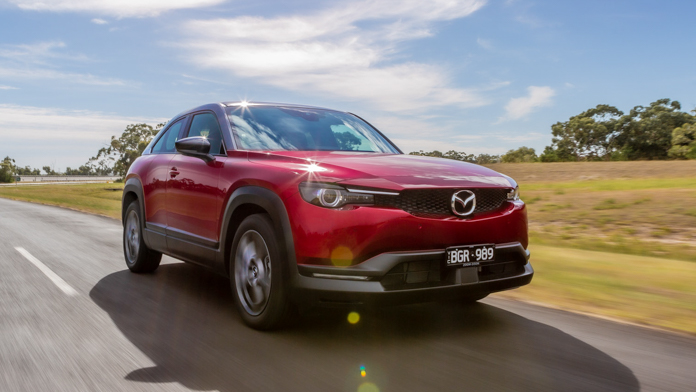
There are shades of Mazda3 – in my eyes, the prettiest small hatch on sale today – to the curvaceous roofline and large rear pillar, while the suicide doors offer a sporty, clean profile. Mazda’s five-point grille is gone, replaced by a cuter, thinner nose leading into deep-set LED headlights, while circular rear lights are more expressive than most afterthought efforts.
Boxy wheel arches add some rugged SUV flavour, while touches such as the Mazda script on a silver plaque where the roof meets the body shows flair. On flagship Astina grades you can take things further, optioning a 3-tone ‘Framed top’ where the body colour contrasts with a silver or grey metallic between the A- and D-pillars, plus a black roof. Far from looking naff, it displays the kind of artistic creativity most designers see rejected for fear the market will find them too polarising.
The entry-level Evolve and Touring score 18-inch silver alloys, the Astina the same size but with a brighter finish. While each grade looks remarkably similar from the outside, cabins and safety enhancements as you move up the range justify the price differences.
If you’re a ‘meat and two veg’ kind of car buyer, don’t be in any way alarmed by the M Hybrid part of the MX-30’s badge. There’s nothing revolutionary here that will change the general driving feel or how you have to drive it – unlike if you go for the MX-30 Electric version, reviewed separately by Chasing Cars.
You’ll find the MX-30 M Hybrid’s overall drive experience very similar to that found in the CX-30 or Mazda3 hatch and sedan – smooth, refined, noise well suppressed and confidence-inspiring handling when pushed. In that regard, the MX-30’s a very approachable unit.
While I’m full of praise for the above, the fact its name emphasises Hybrid so much (the ‘M’ before it will be a mystery to many shoppers) would have you believe there’s plenty of fuel savings to be had. Other brands using mild hybrid tech – Mercedes-Benz for instance – don’t mention the fact at all with their model names.
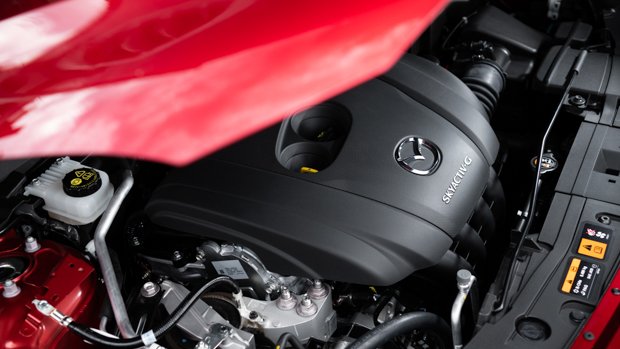
Mild hybrids can’t perform the electric tricks of the likes of Toyota’s full hybrids (the C-HR Hybrid being an obvious rival), where they can travel without the petrol engine running at all for short distances at low speeds. Here, a large-ish battery powers an electric motor to turn the wheels – ideal in town and in traffic.
In contrast, mild hybrids have much smaller batteries, with their motor only having enough juice to, say, start the engine or power the air con. In the MX-30’s case the M Hybrid system’s belt-driven integrated starter generator assists re-starting the engine by spinning the crankshaft after an idling stop, meaning the starter motor’s not needed and, Mazda says, significantly reduces vibration and sound.
In that regard it works well. Before you come to a complete stop the engine subtly switches itself off so you barely notice, with similar non-intrusion when you start to pull away. The M Hybrid system recovers energy on deceleration, and can be used to assist engine torque and enhance braking power. In all honesty, this reviewer didn’t notice any difference in these areas.
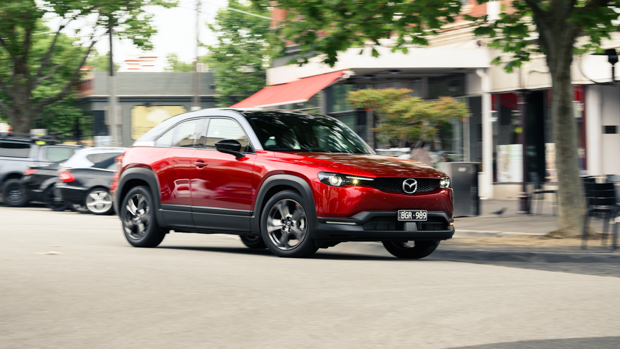
Our test drive route featured very little in the way of urban driving, and on paper, the economy gains are best in stop-start traffic when the idle stop is frequently in action. Even then, the gains versus the non-M Hybrid CX-30 are 0.4L/100km in urban use and 0.1L/100km combined. In other words, you won’t be paying off the mortgage any quicker. For the record, our mix or mainly highway and country driving returned an indicated average of 8.0L/100km.
That’s because we had to work the rather antique 114kW/200Nm non-turbo 2.0-litre four-cylinder engine very hard to promote any urgency. Mazda’s Skyactiv-G motor is a trustworthy thing, but next to its many turbocharged, small capacity rivals it feels sluggish, slurps more fuel and gets a bit uncouth and noisy when you floor the accelerator.
The 2.0-litre may lack personality and poke but keep thing smooth and it purrs along, the six-speed auto doing the cog-swapping pretty seamlessly. Mazda’s also achieved great things with its latest generation cars in terms of noise, vibration and harshness suppression, and the MX-30’s no different. The cabin quiet matches that of many larger premium offerings, and when you remember Mazdas of just a few years ago came under harsh criticism for their noisy interiors, the improvement’s a hefty one.
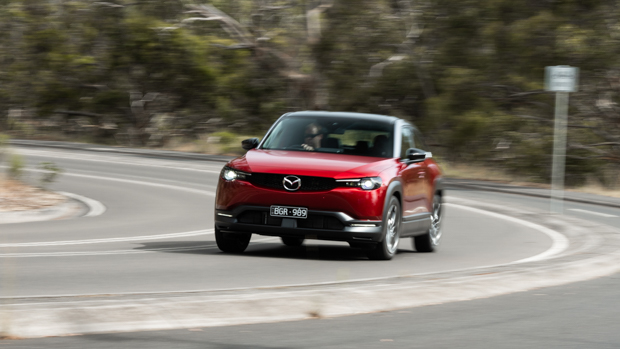
While the MX-30 M Hybrid is targeting city dwellers, it would be wasteful for owners to not seek out more enjoyable drive routes to exploit the very well-rounded chassis and steering. The balance between comfort and handling sees it shine under most conditions, with small bumps mopped up with little fuss, and if you show it a corner the MX-30 turns in sharply with a nice weight to the steering.
The engine robs it of any overwhelming fun, but link a few nice turns together and this stylish SUV brings some joy as it happily changes direction with lovely flow. Paddle shifters and Sport mode mean you can keep the revs high and things get somewhat more responsive, but you sense the engine would prefer to be taking things easy.
There’s been no skimping on active safety across the range. Radar cruise control is always welcome, and while you may get beeped at a fair bit, the monitoring of your blind spot, driver attention, forward obstruction, lane departure and rear cross traffic smother you in security.
Ten airbags, AEB, lane keep assist, smart brake support and traffic sign recognition add to the party, while Astina grades also have a 360-degree monitor, cruising and traffic support, front cross traffic alert and front parking sensors. An extra $1,500 buys you these Astina goodies on the other grades.
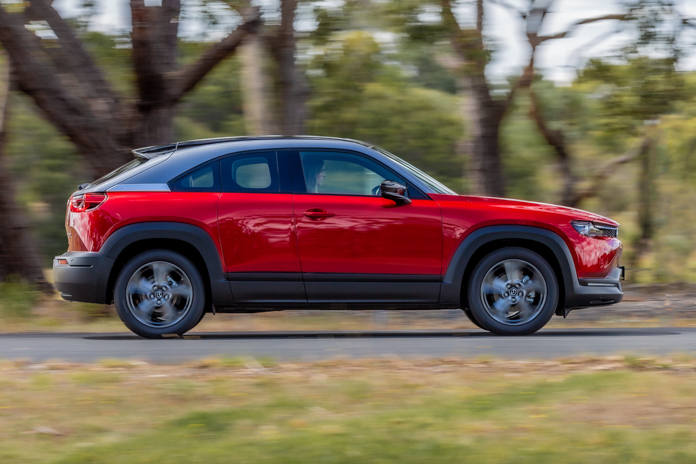
Far from bland. In a good way. If you’re as bored as I am of single colour cabins, the MX-30’s inside offers plenty of conservation and conversation points. Foremost is the use of cork for the centre console’s tray, pair of drink holder covers and door grips. Top eco points come from no trees being chopped down for this job – Mazda’s used leftovers from the production of bottle stoppers. And, as a bit of pub knowledge, Mazda was founded in 1920 as a cork company.
The cork softens the cabin in terms of colour and texture, and the car’s designer personally assured me these nature-sourced parts have been specifically processed and coated to ensure they’re as durable as more familiar cabin plastics. Same applies to the grey door trim using fibres from recycled plastic bottles. It’s a point of difference and certainly not unpleasant to look at, but is hard and I wonder how it’ll endure after a few years in the harsh Australian sun.
New is a cascading centre console with bags of storage (on the cork) underneath, while above is a floating screen to control climate. A sizeable leather gear shifter sits between the screen and a rotary dial alongside other switchgear, but it’s all surrounded by a big slab of hard plastic that looks somewhat out of place amongst all the sustainable touches.
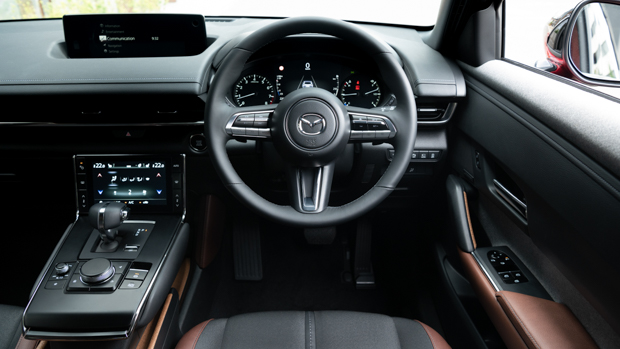
The dash top itself feels soft and almost rubber-like, with the central display – an 8.8-inch widescreen – poking from it is controlled only through the rotary dial (no touchscreen). With a 7-inch TFT display in the instrument cluster you’re well covered digitally, while all the layouts are classy and easy to navigate.
Driving position isn’t lofty over traffic, but forward visibility is good and the uncluttered, clean cabin feels roomy. Eschewing single colours for the seats helps this with the Evolve getting a black and grey cloth combo; the Touring has white Maztex (vegan-friendly) leatherette with grey cloth sections and, the standout, Vintage Brown Maztex with black cloth sections in the Astina. The latter looks akin to something found in an old-world gentleman’s lounge, and is unlike anything else you’ll find for this money in a small SUV.
Now, those freestyle doors. While they facilitate the striking coupe shape, and are of good novelty value, for everyday use they’re not ideal. Not that Mazda expects MX-30 shoppers to be regularly hauling rear passengers. Those front doors need to open before you can open the rears with an internal handle. It’s not a major chore, but rear passengers, especially impatient kids, won’t enjoy the wait to be free at journey’s end.
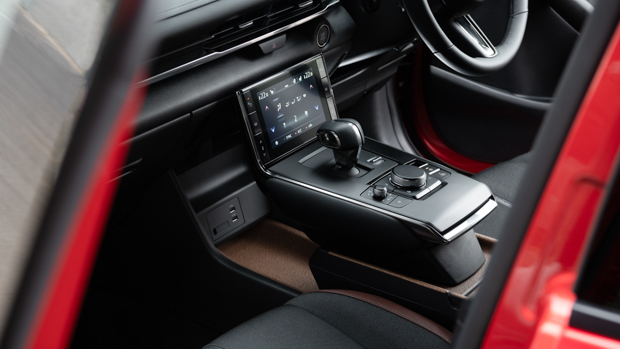
You wouldn’t want more than two in the back, and while head room is good, leg room’s cramped. It’s not uncomfortable per se, but it’s a bit of a clamber to get inside, there are no rear air vents or USB points, and the small windows and low seat position feels a dash claustrophobic.
As for goodies, all MX-30s score keyless start, auto wipers, Apple CarPlay/Android Auto, DAB+, sat nav, dual zone climate control and paddle shifters. The Touring brings keyless entry, that vegan leather cabin and 10-way power driver’s seat, but the Astina looks decent value with its extras. That Vintage Brown finish adds serious luxe, while a glass sunroof, heated front seats, heated steering wheel and excellent Bose sounds, plus the smarter active safety, gives you a lot of kit and style for just over $40k.
Practicality wise the boot is 311-litres – a few Coke bottles down on the CX-30 – so you’ll need to split-fold the 60/40 rear seats if you’re lugging anything sizable. There’s a space saver spare under the floor, and if you’re a buyer going into ownership with eyes open, services are annual or every 10,000km, and will cost $1942 over the first five years.
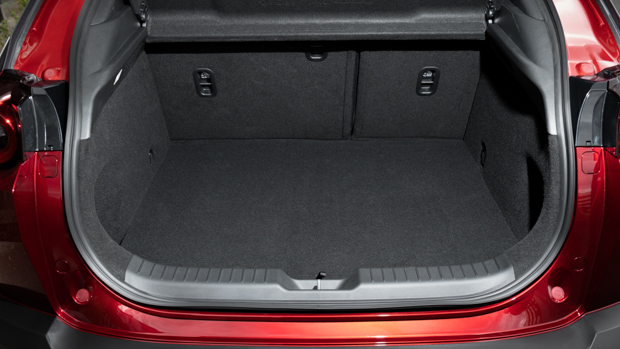
The heritage of ‘MX’ means the MX-30 must be special and even a bit revolutionary. No doubt the Electric version is for the Mazda brand, but the MX-30 M Hybrid muddies the water a bit.
While Mazda’s not pretending it’s anything but a very mild hybrid, its name, to the casual observer at least, does suggest you’re likely to see serious fuel savings. Not so. While the mild hybrid may further smooth an already smooth system in traffic, its 6.4L/100km economy – just 0.1L/100km better than the non M Hybrid CX-30 – is disappointing.
But there’s little else to grumble about. The MX-30 M Hybrid looks a good value, well-equipped offering for those keen on the model’s superb styling inside and out. Its shape has you glancing over your shoulder for another look after parking, while the cabin, especially in Astina grade, has rare panache for a small SUV.
There’s talk of a rotary range extender version, so that and the Electric MX-30 will be the models most deserving of the Mazda Experiment MX badging. But right now, the M Hybrid is most relevant to Australian buyers still coming to terms with the electric car revolution, and there’s little doubt you’ll spot plenty in your local hip suburb in coming months.
Variant tested G20E ASTINA MHEV
Key specs (as tested)
About Chasing cars
Chasing Cars reviews are 100% independent.
Because we are powered by Budget Direct Insurance, we don’t receive advertising or sales revenue from car manufacturers.
We’re truly independent – giving you Australia’s best car reviews.
The estimate provided does not take into account your personal circumstances but is intended to give a general indication of the cost of insurance, in order to obtain a complete quote, please visit www.budgetdirect.com.au. Estimate includes 15%^ online discount.
^Conditions Apply
Budget Direct Insurance arranged by Auto & General Services Pty Ltd ACN 003 617 909(AGS) AFSL 241 411, for and on behalf of the insurer, Auto & General Insurance Company Limited(ABN 42 111 586 353, AFSL 285 571).Because we don’t know your financial needs, we can’t advise you if this insurance will suit you. You should consider your needs and the Product Disclosure Statement before making a decision to buy insurance. Terms and conditions apply.
Indicative quote based on assumptions including postcode , 40 year old male with no offences, licence suspensions or claims in the last 5 years, a NCD Rating 1 and no younger drivers listed. White car, driven up to 10,000kms a year, unfinanced, with no modifications, factory options and/or non-standard accessories, private use only and garaged at night.
^Online Discounts Terms & Conditions
1. Discounts apply to the premium paid for a new Budget Direct Gold Comprehensive Car Insurance, Third Party Property Only or Third Party Property, Fire & Theft Insurance policy initiated online on or after 29 March 2017. Discounts do not apply to optional Roadside Assistance.
2. Discounts do not apply to any renewal offer of insurance.
3. Discounts only apply to the insurance portion of the premium. Discounts are applied before government charges, taxes, levies and fees, including instalment processing fees (as applicable). The full extent of discounts may therefore be impacted.
4. We reserve the right to change the offer without notice.